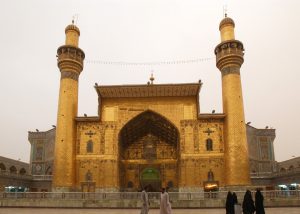The First Fitna and the Origins of Shi‘ism
Niall Christie

‘Ali ibn Abi Talib was a popular and influential member of the Muslim community. He was an early convert to Islam (many regard him as the first male to convert to Islam), an unwavering supporter of the Prophet, a brave warrior, the Prophet’s cousin, and had become his son-in-law when he married the Prophet’s daughter Fatima (d. 633). ‘Ali had been considered for the position of caliph as early as the death of Muhammad (indeed, Shi‘ites maintain that before he died the Prophet designated ‘Ali to succeed him), but was not raised to the position until the death of ‘Uthman. As indicated previously, ‘Ali was raised to the caliphate by troops from Egypt and Iraq, and he soon gained further support in Medina, but not everyone agreed. The result was that the Muslim community became split, and a civil war broke out. This was the first fitna, an important Arabic word denoting both a civil war and time of trials or temptation, when the unity of the Muslim community was seriously threatened.
‘Ali’s election was initially opposed by a faction in Medina led by a number of friends and associates of the Prophet, including the Prophet’s wife ‘A’isha. They opposed ‘Ali’s elevation on the grounds that ‘Ali was not seeking to bring the murderers of ‘Uthman to justice (which, given that they were among his supporters, he could not do). Both sides gathered their forces, and in late 656 they met in battle near Basra in Iraq. The conflict is known as the Battle of the Camel, it is said, because ‘A’isha watched it from camel-back. ‘Ali’s forces carried the day, the principal leaders of his opponents were killed, and ‘A’isha went into retirement in Medina.
However, this was not the end of the opposition to ‘Ali. According to tradition ‘Uthman’s widow sent her husband’s bloodstained shirt to his closest relative, Mu‘awiya ibn Abi Sufyan, who was at the time the governor of Syria. Mu‘awiya now took up the calls for justice for the murder of ‘Uthman and became the focus of opposition to ‘Ali. The two men assembled their armies and confronted each other at Siffin, on the Euphrates, in 637. Neither side was keen to commit to a major battle, but after three months of occasional skirmishes, when serious fighting finally broke out, Mu‘awiya’s followers called for an arbitration, apparently after riding out with copies of the Qur’an on their lances to bring the conflict to a stop. ‘Ali was forced to agree, but some of his followers objected and abandoned him; they became known as kharijis, from the Arabic verb kharaja (to go out) because they went out from ‘Ali’s army. The term later became extended to a number of both violent and non-violent movements who objected to the activities or beliefs of the majority of the Muslims.
The arbitration took place at Adhruh[1] in 658 or 659, but the results were inconclusive and no agreement was reached. ‘Ali was by now also opposed by the kharijis, whom he defeated in battle and scattered in 659, but his support continued to decline. Meanwhile, Mu‘awiya was able to secure the backing of increasing numbers of important tribal leaders and the governor of Egypt, and in 660 his followers acclaimed him as caliph in Damascus. The following year ‘Ali was assassinated, while praying in the mosque at Kufa, by a khariji named Ibn Muljam, who is said to have used a poisoned sword. Some acclaimed ‘Ali’s son al-Hasan (d. 669) as the new caliph, but Mu‘awiya intimidated him into going into retirement at Mecca. This did not mean, however, that supporters of ‘Ali’s family gave up, and they continued to assert the claims of the Prophet’s family, through the line of ‘Ali, to the caliphate. For them ‘Ali became a symbol, a great man brought down by the impiety and malice of his enemies and the inconstancy of his allies. Thus he and his family, especially those born of Fatima, who were after all direct descendants of the Prophet, became foci for protest movements, in particular those who objected to the conduct of the current rulers and demanded a more pious and just society.
Supporters of the claims of the family of ‘Ali are known as shi‘at ‘Ali, “the party of ‘Ali,” which we anglicise as “Shi‘ites.” Over time they divided into a number of different groups, while also being a source of periodic rebellions against the rulers of the majority of the Muslims, whom we refer to as “Sunnis.” Today Sunnis comprise roughly 85% of the Muslims in the world, with most of the remaining 15% following various forms of Shi‘ism. We will examine the origins of some of these in the forthcoming section of The Ancient & Medieval World that deals with the Umayyads and ‘Abbasids.

Media Attributions
- Hakob Hovnatanian – Ali ibn Abi Talib © Hakob Hovnatanyan is licensed under a Public Domain license
- Facade of the Meshed Ali, Najaf, Iraq © Arlo K. Abrahamson is licensed under a Public Domain license
- Modern Udhruh, Jordan. ↵

